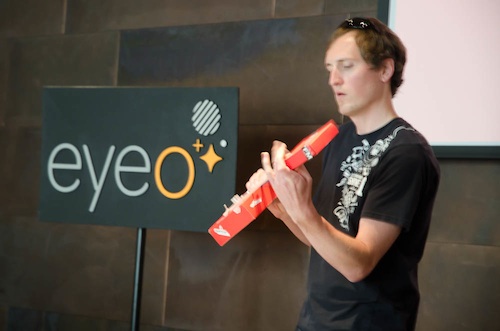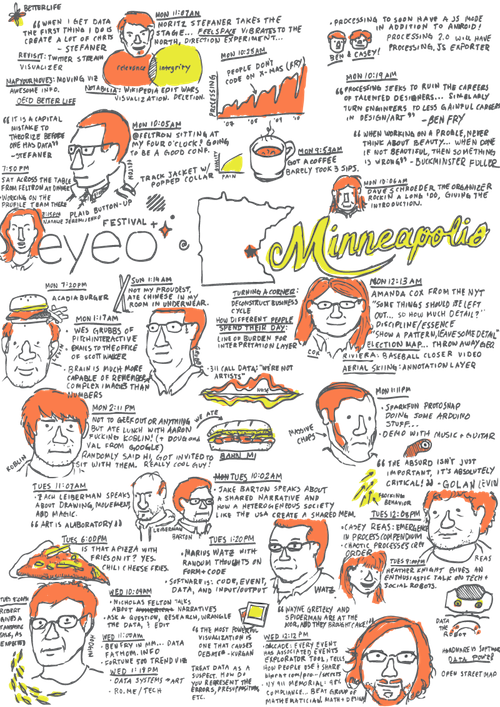EYEO Wrap-up
SparkFun heads out to Minneapolis for a gathering of the minds at the crossroads of art, technology, and science - the EYEO Festival.
It would be incredibly difficult to summarize the EYEO Festival without diminishing the impact of this event. From the perspective of the organizers, "It’s an exciting time to be interested in art, interaction, and information. The way we experience all three is changing. The way creative minds employ technology gives us a glimpse into what’s possible, and things to come. Access to data and tools has entered a new realm. What data is- is changing; It’s a social media feed, it’s waving your finger at a sensor, it’s open access to oceans of digitized archives. Tools are built from scratch, hacked and repurposed as needed. We are immersed in a sea of ones and zeros floating around us just waiting to send and deliver another new experience. The Eyeo Festival brings together the most exciting people creating these experiences today. Three days of inspirational talks, demos, labs, and workshops and opportunities to connect with people whose extraordinary creations are pushing the envelope. The line up is amazing. 30 brilliant individuals, one amazing collection of talent and insight. Add yourself to the mix, and it just gets better. Converge to Inspire – Indeed."
A small group of SparkFunners headed out to Minneapolis to experience the EYEO Festival. The three-day event was full of seminars, panels, and workshops highlighted by some incredibly big names in the related fields. This was an exciting event for SparkFun because we had the opportunity to beta test a new and exciting product called the ProtoSnap Pro-Mini. There will be plenty of information to come in the near future about this new line of products but suffice it to say that it is a fantastic tool for introducing Arduino programming without the hassle of solder, wires, etc. Our expectations of around 50 people were easily surpassed as we estimate close to 70 people packed into the Maroon & Gold room at the McNamara Alumni Center for our workshop. Honestly, this must have created some difficult decision-making on attendees as this time slot also included a workshop on Computer Vision in Processing with Golan Levin and Kyle McDonald, a hands-on workshop on making Hele-Shaw cells with Jesse and Jessica of Nervous System, as well as the first of a two-part series on data visualization with Jer Thorp and Wes Grubbs

Pete rocks so hard no camera can focus on him or it would explode!
Casey Haskell, Pete Lewis, and Dave Stillman instructed and entertained the students through a history of Arduino, an introduction to the Arduino programming environment and some fundamentals including digital input/output, analog input/output, if/else statements, for loops, serial communication and more. Following each major section students were given playtime to fiddle with the code and explore the outcome of changing pin numbers, inputs, and outputs. Of course, we had "that guy" that prematurely discovered the "dentist drill" sketch and proceeded to serenade the class with buzzer noises throughout the workshop. Despite a little ringing in the ears, there is nothing better than seeing the enjoyment of people finally jumping into physical computing, learning to code, and playing. At the end of the workshop Pete and Dave did a show-and-tell with projects they created using the boards in the ProtoSnap Pro-Mini. Dave's alarm box was a hit and Pete rocked out with his "guitarduino." Nearly every person who attended happily delivered the requested donation to keep the ProtoSnap Pro-Mini, a great testament to the instructors and excitement of the attendees. All proceeds from the workshop will be donated to the Science Museum of Minnesota
The energy of this festival was palpable - quite unlike most 'gatherings of the minds' that I attended in my former life as a research scientist. The attendees soaked in all of the information and inspiration that EYEO hurled with every minute of the tightly-packed schedule. There was no shortage of digital participation either as many attendees flooded the social networks with commentary, links, invitations, and quips about Minneapolis. One of my personal favorite presenters, Moritz Stefaner, created an applicaton called "revisit" that elegantly displays the #eyeo Twitter feed. I didn't see a single face wearing the familiar look of "my boss made me come to this." I'm quite confident that most people attended EYEO for their own personal interest, gains, and amusement. The EYEO Festival rapidly created a sense of community and there was no shortage of inspiring projects. Here are some thoughts from some of the other SparkFunners who attended:
Pete Dokter
So we're back from the EYEO Festival. I have to admit I initially used this as an excuse to visit my home town (Minneapolis), but also to take part in teaching a workshop, which I hadn't done. And upon reading the list of presentations, my first reaction was something akin to "Wait, what? Data visualization? What's wrong with a bar graph? Oh, you mean a pie chart. I can dig it." Clearly, I could not. I'm no stranger to abstractions but this was all new. Turns out there are about as many ways to visualize data as there are people to interpret it for you, and changing the visualization slightly can expose all kinds of behavioral nuances, sometimes with stark results. In a nutshell, it was an educational experience for me. But the greater question I needed to answer was "what do we have in common with these guys and why are we here?" And, I'll be honest, I'm still not totally clear on that. But there's no doubt that the workshop went off HUGE. Apparently, the EYEOites have a better idea about what we do at SparkFun than I do about what they do, and they want to incorporate our hardware with their work. Well, I can't say no to that, can I? So to all the EYEO crew, thanks for my brief immersion in your art, for it truly is an art. Lastly, shout out to my favorite presenter, John Keston, who has used Processing to create the Gestural Music Sequencer which "converts video input into musical phrases". Seriously cool, and please go check it out.
Jim Lindblom
Sometimes you need a reminder of just how closely engineering and art are related. The EYEO festival provided plenty of examples of this relationship. Whether it be beautiful, informative graphs, crazy music visualizations, hugely collaborative music videos, or kid-friendly museum installations, all of the talks were both inspirational and informative. Even more inspiration came from getting a first-hand view of the ProtoSnap Pro-Mini in the wild, doing its thing. Being able to see so many people getting so much joy, and knowledge out of something I helped design meant a lot to me.
Casey Haskell
Starting EYEO with a stomach bug and the SFE presentation on the first day didn't seem like a stellar start to the three-day festival yet the potential lame factor diminished as soon as the slides started and LEDs were blinking. Being such a digital/visual arts geared conference focused on Processing and similar programs, many attendees at our talk were very excited to see the direct connection between programming and manipulating hardware. They were so excited I think only two people did not donate the requested $20 for the ProtoSnap Pro-Mini only due to lack of cash. To me, the highlight of the festival was the location of the "after parties." Typically combined with a presentation or two, the EYEO organizers did an awesome job of location scouting for these events. The two most memorable places were the Varsity Theater where Robert Hodgin led an entertaining talk about his experiments in combining real world input (music, video feed, etc) with digital visualization and Nye's Polonaise Room. This funky little Polish dinner club was a great venue for the final EYEO hurrah where new ideas were bounced off of new acquaintances.
We were without our fantastically talented photographer or videographer so apologies for the lack of documentation. Despite having always been an avid note-taker, I decided to sit back and soak it all in this time. I enjoyed the lack of pressure to jot down every word uttered by the amazing presenters, but coming home without the journal to remind me of our fun-filled adventure was a bit sad. I did end up stumbling upon a graphical representation of another EYEO attendee's (Michael Wang) first day and thought it was the perfect image to sum up the experience. Check it out above - if you look closely you might even catch a doodle of our very own Casey Haskell and his impressive chops!
I would recommend this festival to anyone who is interested in participating in the interplay of art, science, technology, and communication. The people presenting and attending this event are pushing the boundaries on how we experience the massive influx of information that surrounds us at all times. It would be an incredibly difficult challenge to narrow down all of the amazing projects we saw to discuss one or even a few. If you're interested in learning more about the inspiring work discussed at EYEO, I recommend checking out this blog from Megan Erin Miller. A hearty thank you goes out to Dave Schroeder and everyone involved in organizing the EYEO Festival, we had a fantastic time and look forward to 2012!







